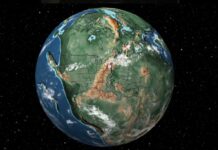
This image of the Sculptor Galaxy was stitched together with 100 exposures over 50 hours of observations to make a never-before-seen visual, 65,000 light years from side to side.
Using the European Southern Observatory’s Very Large Telescope (ESO’s VLT), astronomers observed this nearby galaxy in thousands of colors simultaneously. By capturing vast amounts of data at every single location, they created a galaxy-wide snapshot of the lives of stars within Sculptor.

Researcher at the ESO, Enrico Congiu, who led a new Astronomy & Astrophysics study on Sculptor, reminds us that even though we’ve been looking at and studying galaxies in detail for almost a century, they are still incredibly complex objects that we “struggle” to understand.
Located 1.1 million light years from Earth, the vast Sculptor Galaxy contains around 500 nebulae, or star-forming regions rich in gas and dust. Putting some context on that number, we generally detect around 100 nebulae with previous methods for observing galaxies.
These areas emit light in many different colors, and the science of spectroscopy can use these colors to clue scientists in on the age, activity, and even motion of the stars therein.
To use the second image as an example, specific wavelengths of light are released by hydrogen, nitrogen, sulfur and oxygen and show up as different colors. These elements exist in gas form all over the galaxy, but the mechanisms causing this gas to glow can vary throughout.
GREAT ASTRONOMY IMAGES:
- Neptune’s Long-Hidden Auroras Are Captured for the First Time–While Revealing a New Mystery
- Astro-Photographer Reveals a Cosmic Grinch in a Holiday-Themed Star Cluster
- Hubble Telescope Still Hard at Work Snapping Photos Like This Star-Packed ‘Triangulum Galaxy’
- Scientists Have Spotted a ‘Bejeweled Ring’ in Space – Revealing a Sparkling Quasar
The pink light represents gas excited by the radiation of newborn stars, while the cone of whiter light at the centre is caused by an outflow of gas from the black hole at the galaxy’s core.
Captured by the spectrograph instrument at the ESO’s Very Large Telescope array across the Southern Hemisphere, Sculptor sits at a sweet spot where it’s close enough to Earth to be seen in very precise detail but far enough away that the study authors could fit the whole thing in a single image.
“We can zoom in to study individual regions where stars form at nearly the scale of individual stars, but we can also zoom out to study the galaxy as a whole,” said co-author Kathryn Kreckel from Heidelberg University, Germany.
SHARE This Great Observation With Your Friends On Social Media…




















